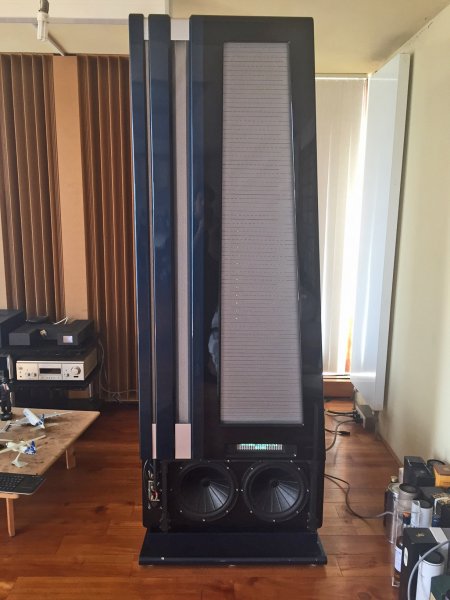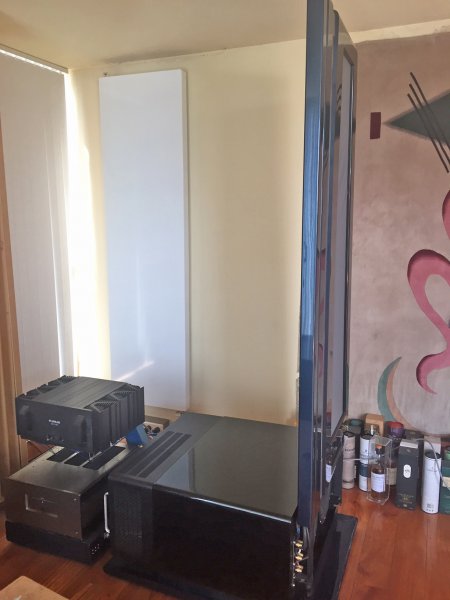On July 9, 2016, my wife and I visited Henk van der Hoeven, world-renowned re-builder/restorer of vintage Apogee Acoustics speakers. Henk will work on speakers a customer sends to him, or a customer can buy a pair from Henk’s existing inventory of un-reconditioned speakers. Henk currently has in inventory several pairs of stock Apogee Full Range speak-ers awaiting customer requests for re-building.
Henk lives in a small town called Moerkapelle, which is about 35 minutes northeast of The Hague in the Netherlands. Moerkapelle is a cute town near farming areas. Henk is an engineer for an aircraft manufacturer.
Before even entering Henk’s nice house I had a laugh: Henk’s front door with a glass window is made in the shape of a complete Apogee Acoustics speaker!
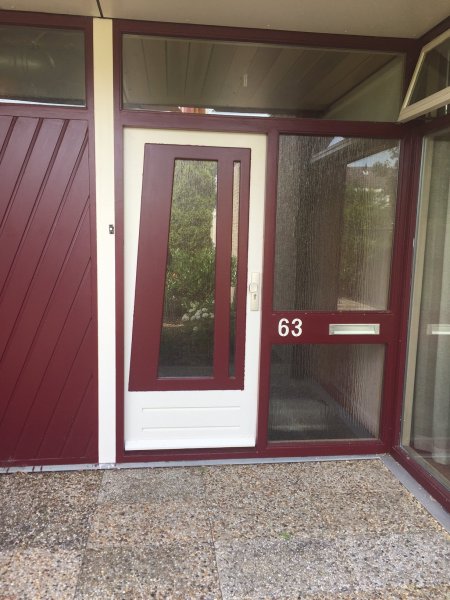
I did not bring my usual audition LPs, because Henk does not have LP playback capability. He is into digital streaming only. His database can access approximately 42,000 music tracks!
When I made the appointment over e-mail to see Henk, and I learned that he cannot play LPs, he sent me his entire list of tracks. It took me literally several hours to go line by line through that list and to select 10 to 12 can-didates for playing during our visit.
Since I could not play my standard audition LPs please consider this report a manufacturer (ah, re-builder/restorer) visit report and not a full speaker review.
Henk’s room is about 17 feet wide and about 40 feet long. He has behind the speakers on the front wall a duplicate of RPG Skyline diffusers in wood, which he built himself.
Henk is in the process of re-building a pair of Apogee Grands which he purchased in poor condition from someone in Indonesia. The speaker frames are a pretty, dark blue metallic. These are the speakers set-up in his shop.
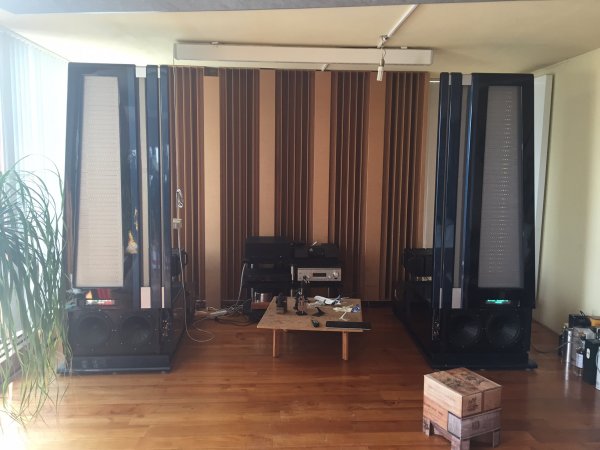
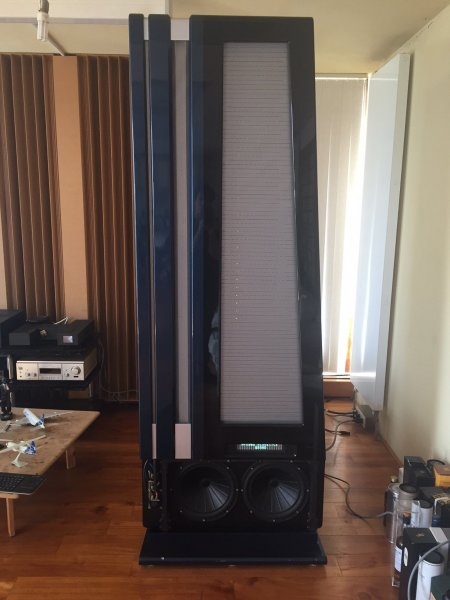
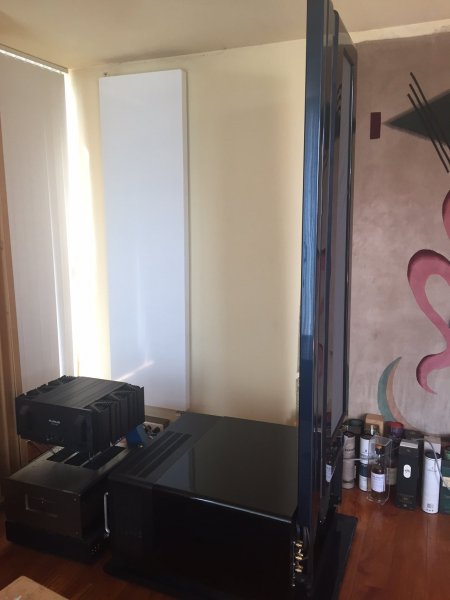
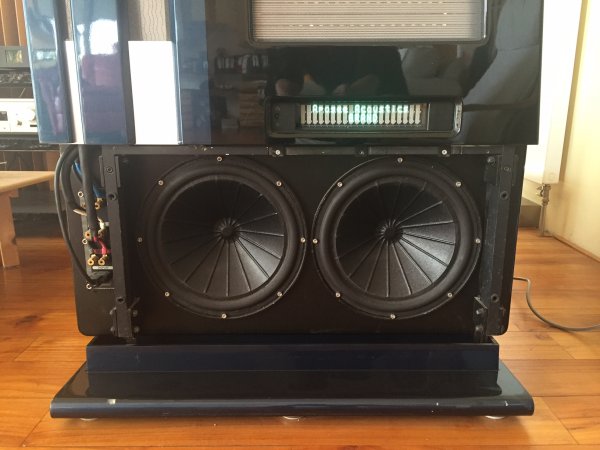
The Grand is a tall speaker with a very deep base section (it looked about three feet long) containing the 12” cones and crossover and amplifier elec-tronics. Each Grand has a very complex, built-in electronic crossover. The two 12 inch woofers per speaker are internally powered. Henk is driving the woofer panels with Plinius monaural amplifiers, and he is driving the midrange ribbons with Stax monaural amplifiers. The tweeter ribbons are driven by Krell amps built into the Grands.
The internal cross-over electronics send the low frequencies to the woofer cones, the next range up to the bass panel, part to the midrange ribbon and the high frequencies to the tweeter ribbon. I did not ask Henk for the cross-over points.
Henk said he replaced 52 op-amps in the internal electronics in each Grand. How the circuit could utilize 52 op-amps I have no idea, but it certainly makes for a complex piece of equipment.
On the side of the room stood recently completed Duetta speakers which showed a beautifully clean and smooth paint finish. On a work-desk at the rear of the room Henk was displaying his replacement cross-overs for Full Range speakers. The original crossover was next to the new crossover, and the new crossover looked well-engineered; it was beautiful with gleam-ing new components. The original crossover looked poorly made with me-diocre components compared to Hank’s completely new replacement.
This new cross-over demonstrated not only only Henk’s electronics engineering talent but also his use of the highest-quality components as well as his sensitivity to aesthetic design.
Henk procures his replacement woofer panels and ribbon drivers from Graeme "Graz" of Apogee Acoustics in Australia. (Graz bought the Apogee Acoustics an some years ago.) Henk is very happy with the quality of the ribbons he gets from Graz. I asked Henk about the sample to sample variation he experiences in the drivers he receives from Graz, and Henk said that he finds copies of the same driver to be essentially identical.
In addition to replacing the original Apogee drivers Henk remanufactures the frame of the speakers with steel and aluminum. I think the re-built Henk speakers are physically superior -- stronger, sturdier, heavier and less resonant -- to the original Apogee speakers.
We played:
A digital source -- a Phasure NOS1a -- with all solid-state electronics and and a complex, solid-state crossover is not, at the outset, my cup of tea, so what did I hear?
The midrange was warm and absolutely ravishing. Jennifer Warnes' voice was deeper and richer than it usually is. Since I was not at the original re-cording of the songs on Famous Blue Raincoat is this rendition of Jennifer’s voice more accurate and correct, or is the more typical and slightly lighter tonal balance more accurate and correct? There is no way to know. What I do know is that I want the richness and warmth and naturalness I heard from this system (and from solid-state and digital, no less!).
Interestingly, I think that Jeff Buckley’s voice did not sound noticeably deeper or richer than usual. My wife, the Jeff Buckley “Hallelujah” expert, said that Jeff sounded as good as she as ever heard him.
Low frequencies were extremely detailed and very clearly defined. The drums on "Bird on a Wire" sounded as clean and as detailed as I have ever heard them. I would write that I heard low frequencies sound more weighty, rich and powerful than two 12 inch cones per speaker have any right to sound, but I think I was hearing the articulate and powerful low frequencies coming from the big woofer panels.
While the midrange was rich and wonderful, and, to me, perfect, and the low frequency reproduction was also, to me, close to perfect, I believe the overall tonal balance was dark. I definitely felt that the highest frequencies were shaved off and that this caused some loss of upper end air and detail. But that upper end detail and whiteish-ness is what I usually find personally objectionable in flat frequency response speakers.
I asked Henk if he thought the speakers have a tilted down tonal balance. He said he has thought that from time to time and, as a result, he has boosted the tweeter ribbon level by 5 dB.
So what to make of the dark overall tonal balance? If you like Magico speakers or other dynamic driver speakers of the-“fast sound” variety (e.g., Marten, Tidal Audio), then I think you will find Henk’s Grands insufficiently detailed and “open” in the high frequencies. If you like Rockport Technolo-gies speakers then these Apogees are the ribbon speakers for you! I love the tonal balance I heard. Intellectually I know I was missing some highest frequency detail and air, but I did not care. The sound was natural, real and emotionally-involving.
I feel that vocals were not quite as transparent as MartinLogan electrostatic panels, but I attribute this mostly to the digital playback. I said to myself -- and to Henk -- several times that I wish I could hear this system playing vinyl.
I asked Henk about the sample to sample variability of the pairs of speakers he re-builds. Will the Full Range Henk re-builds I receive measure and sound the same as the Full Range Henk re-builds you receive? Henk believes “yes.”
Finally, I asked Henk how he feels about the 12 inch dynamic drivers in the bottom of the Grand cabinet. Henk agrees with me that cones in the bot-tom of the cabinet is not the ideal design. He, too, believes that a vertical array of cones is the best implementation of a dynamic driver subwoofer system.
For some comparisons the Analysis Audio Amphitryon is relatively reasonably priced and, I think, gives you a large fraction of what I liked about Henk's Grands. The woofer panel in even the Magnepan 20.7 is not nearly as powerful or dynamic as is the woofer panel in the Grand. I think the Grand's midrange ribbon driver, while not as perfectly transparent as the MartinLogan Neolith, adds body and dimensionality and realism in return for a smidgen less transparency.
My wife and I thank Henk for a wonderful time!
Henk can be contacted at +31650290136 and henk_van_der_hoeven@yahoo.com.
* * *
Postscript: I visited Steve today to catch up with I'm before I go back to London. I brought with me a CD of the Genesis album with the “Drum Duet” track -- with Phil Collins playing the drum kit on the left side of the stage and his colleague playing a drum kit on the right side of the stage. (Henk very kindly gave me his CD of that album.)
When the track was finished at Henk’s place my wife and I turned to each other and each of us basically said “Oh my God, that was amazing!” So I was really curious to hear this drum track on Steve’s very full-range and bass capable system. (Steve supplements his big Wilsons with JL Audio Fathoms.)
On Steve’s system the drum track today was very good but it was not involving and mesmerizing like it was on Henk’s system. Listening to the drums on the Grands seemed to my wife and me like an experience.
This is absolutely no criticism of Steve’s system. As I have written many times I love the sound from Steve’s system. I am very confident what I heard from this track on the Grands versus on conventional cones means that Kedar was correct about the amazing bass reproduction on the Grands: the woofer panel on the Grands -- which covers about 70 Hz to about 250 Hz -- is the best reproducer of that frequency range I have ever heard in my life. I do not think any dynamic driver speaker -- not Wilsons, not Genesis woofer towers, not Pendragon woofer towers, not any set of cones -- is going to reproduce 70 Hz or so to 250 Hz or so with the articulation and realism and power of those big, trapezoidal woofer panels on the Grands.
Before Steve played the drum track on CD we listened on LP to a new jazz album he recently received. I think the music on this jazz album frequently activated the Fathoms. When we played the drum track I don't think the Fathoms were activated often, if at all.
I think that Henk knew exactly what he was doing when he demonstrated the Grands with “Drum Duet.” He wanted to show what the Grands’ woofer panels could do above the two 12 inch cones in the Grands.
So where does this leave me in my speaker journey? I think that vintage Apogee Acoustics Grand speakers have a midrange ribbon driver which, overall, offers the very best midrange sound I have ever heard. The Grand also offers the best mid-bass to upper bass reproduction I have ever heard.
But so what? The Apogee Grand is not a production item today. Unlike for Henk’s customers rebuilding vintage speakers is too DIY for me (even if I'm not actually doing it myself). Even if Apogee re-builders all use Graz replacement ribbons different Apogee re-builders do different things with cabinets, cross-overs, transformers, etc. For me personally, that is just too fuzzy. In contrast, people like Kedar like the idea that the re-builder can modify whatever you want and that you can create a unique speaker, and that you can upgrade it with better and better components over time as finances permit.
I want a truly production item (even if it is low production) where the designer achieves his sonic goals in paper, metal, wood and aluminum, and each copy of the speaker measures and sounds the same. Also, for me personally, I want to use tube, or at least hybrid, power amplifiers. Graz allegedly has made great progress with his ribbons to increase the sensitivity of the re-built speakers. But I do not want to be the one to blaze a new trail with unproven driver/cross-over/amplifier combinations.
If you are more adventurous in this area than I am, and you like the idea of helping to design your own speaker, then you should contact Henk. Add a pair of top-quality cone subwoofers to Henk's Full Ranges and there is a good chance you will wind up with sound close to or at the state-of-the-art.
It certainly is clear and obvious to me why Apogee Acoustics has such a devoted following even today, and why many experienced audiophiles (e.g., DDK) devoted years to getting the best out of their Apogee speakers!
Henk lives in a small town called Moerkapelle, which is about 35 minutes northeast of The Hague in the Netherlands. Moerkapelle is a cute town near farming areas. Henk is an engineer for an aircraft manufacturer.
Before even entering Henk’s nice house I had a laugh: Henk’s front door with a glass window is made in the shape of a complete Apogee Acoustics speaker!

I did not bring my usual audition LPs, because Henk does not have LP playback capability. He is into digital streaming only. His database can access approximately 42,000 music tracks!
When I made the appointment over e-mail to see Henk, and I learned that he cannot play LPs, he sent me his entire list of tracks. It took me literally several hours to go line by line through that list and to select 10 to 12 can-didates for playing during our visit.
Since I could not play my standard audition LPs please consider this report a manufacturer (ah, re-builder/restorer) visit report and not a full speaker review.
Henk’s room is about 17 feet wide and about 40 feet long. He has behind the speakers on the front wall a duplicate of RPG Skyline diffusers in wood, which he built himself.
Henk is in the process of re-building a pair of Apogee Grands which he purchased in poor condition from someone in Indonesia. The speaker frames are a pretty, dark blue metallic. These are the speakers set-up in his shop.




The Grand is a tall speaker with a very deep base section (it looked about three feet long) containing the 12” cones and crossover and amplifier elec-tronics. Each Grand has a very complex, built-in electronic crossover. The two 12 inch woofers per speaker are internally powered. Henk is driving the woofer panels with Plinius monaural amplifiers, and he is driving the midrange ribbons with Stax monaural amplifiers. The tweeter ribbons are driven by Krell amps built into the Grands.
The internal cross-over electronics send the low frequencies to the woofer cones, the next range up to the bass panel, part to the midrange ribbon and the high frequencies to the tweeter ribbon. I did not ask Henk for the cross-over points.
Henk said he replaced 52 op-amps in the internal electronics in each Grand. How the circuit could utilize 52 op-amps I have no idea, but it certainly makes for a complex piece of equipment.
On the side of the room stood recently completed Duetta speakers which showed a beautifully clean and smooth paint finish. On a work-desk at the rear of the room Henk was displaying his replacement cross-overs for Full Range speakers. The original crossover was next to the new crossover, and the new crossover looked well-engineered; it was beautiful with gleam-ing new components. The original crossover looked poorly made with me-diocre components compared to Hank’s completely new replacement.
This new cross-over demonstrated not only only Henk’s electronics engineering talent but also his use of the highest-quality components as well as his sensitivity to aesthetic design.
Henk procures his replacement woofer panels and ribbon drivers from Graeme "Graz" of Apogee Acoustics in Australia. (Graz bought the Apogee Acoustics an some years ago.) Henk is very happy with the quality of the ribbons he gets from Graz. I asked Henk about the sample to sample variation he experiences in the drivers he receives from Graz, and Henk said that he finds copies of the same driver to be essentially identical.
In addition to replacing the original Apogee drivers Henk remanufactures the frame of the speakers with steel and aluminum. I think the re-built Henk speakers are physically superior -- stronger, sturdier, heavier and less resonant -- to the original Apogee speakers.
We played:
-- "First We Take Manhattan," "Bird on a Wire," "Joan of Arc" and "Song of Bernadette" from Jennifer Warnes' and Leonard Cohen’s Famous Blue Raincoat
-- Jeff Buckley’s “Hallelujah” (Grace)
-- Nick Cave’s “Where the Wild Roses Grow”
-- Mussorgsky’s “Night on Bald Mountain” and
-- “Drum Duet” from the Genesis live album The Way We Walk -- which was quite fantastic (this was Henk’s selection which I had never heard before)
-- Jeff Buckley’s “Hallelujah” (Grace)
-- Nick Cave’s “Where the Wild Roses Grow”
-- Mussorgsky’s “Night on Bald Mountain” and
-- “Drum Duet” from the Genesis live album The Way We Walk -- which was quite fantastic (this was Henk’s selection which I had never heard before)
A digital source -- a Phasure NOS1a -- with all solid-state electronics and and a complex, solid-state crossover is not, at the outset, my cup of tea, so what did I hear?
The midrange was warm and absolutely ravishing. Jennifer Warnes' voice was deeper and richer than it usually is. Since I was not at the original re-cording of the songs on Famous Blue Raincoat is this rendition of Jennifer’s voice more accurate and correct, or is the more typical and slightly lighter tonal balance more accurate and correct? There is no way to know. What I do know is that I want the richness and warmth and naturalness I heard from this system (and from solid-state and digital, no less!).
Interestingly, I think that Jeff Buckley’s voice did not sound noticeably deeper or richer than usual. My wife, the Jeff Buckley “Hallelujah” expert, said that Jeff sounded as good as she as ever heard him.
Low frequencies were extremely detailed and very clearly defined. The drums on "Bird on a Wire" sounded as clean and as detailed as I have ever heard them. I would write that I heard low frequencies sound more weighty, rich and powerful than two 12 inch cones per speaker have any right to sound, but I think I was hearing the articulate and powerful low frequencies coming from the big woofer panels.
While the midrange was rich and wonderful, and, to me, perfect, and the low frequency reproduction was also, to me, close to perfect, I believe the overall tonal balance was dark. I definitely felt that the highest frequencies were shaved off and that this caused some loss of upper end air and detail. But that upper end detail and whiteish-ness is what I usually find personally objectionable in flat frequency response speakers.
I asked Henk if he thought the speakers have a tilted down tonal balance. He said he has thought that from time to time and, as a result, he has boosted the tweeter ribbon level by 5 dB.
So what to make of the dark overall tonal balance? If you like Magico speakers or other dynamic driver speakers of the-“fast sound” variety (e.g., Marten, Tidal Audio), then I think you will find Henk’s Grands insufficiently detailed and “open” in the high frequencies. If you like Rockport Technolo-gies speakers then these Apogees are the ribbon speakers for you! I love the tonal balance I heard. Intellectually I know I was missing some highest frequency detail and air, but I did not care. The sound was natural, real and emotionally-involving.
I feel that vocals were not quite as transparent as MartinLogan electrostatic panels, but I attribute this mostly to the digital playback. I said to myself -- and to Henk -- several times that I wish I could hear this system playing vinyl.
I asked Henk about the sample to sample variability of the pairs of speakers he re-builds. Will the Full Range Henk re-builds I receive measure and sound the same as the Full Range Henk re-builds you receive? Henk believes “yes.”
Finally, I asked Henk how he feels about the 12 inch dynamic drivers in the bottom of the Grand cabinet. Henk agrees with me that cones in the bot-tom of the cabinet is not the ideal design. He, too, believes that a vertical array of cones is the best implementation of a dynamic driver subwoofer system.
For some comparisons the Analysis Audio Amphitryon is relatively reasonably priced and, I think, gives you a large fraction of what I liked about Henk's Grands. The woofer panel in even the Magnepan 20.7 is not nearly as powerful or dynamic as is the woofer panel in the Grand. I think the Grand's midrange ribbon driver, while not as perfectly transparent as the MartinLogan Neolith, adds body and dimensionality and realism in return for a smidgen less transparency.
My wife and I thank Henk for a wonderful time!
Henk can be contacted at +31650290136 and henk_van_der_hoeven@yahoo.com.
* * *
Postscript: I visited Steve today to catch up with I'm before I go back to London. I brought with me a CD of the Genesis album with the “Drum Duet” track -- with Phil Collins playing the drum kit on the left side of the stage and his colleague playing a drum kit on the right side of the stage. (Henk very kindly gave me his CD of that album.)
When the track was finished at Henk’s place my wife and I turned to each other and each of us basically said “Oh my God, that was amazing!” So I was really curious to hear this drum track on Steve’s very full-range and bass capable system. (Steve supplements his big Wilsons with JL Audio Fathoms.)
On Steve’s system the drum track today was very good but it was not involving and mesmerizing like it was on Henk’s system. Listening to the drums on the Grands seemed to my wife and me like an experience.
This is absolutely no criticism of Steve’s system. As I have written many times I love the sound from Steve’s system. I am very confident what I heard from this track on the Grands versus on conventional cones means that Kedar was correct about the amazing bass reproduction on the Grands: the woofer panel on the Grands -- which covers about 70 Hz to about 250 Hz -- is the best reproducer of that frequency range I have ever heard in my life. I do not think any dynamic driver speaker -- not Wilsons, not Genesis woofer towers, not Pendragon woofer towers, not any set of cones -- is going to reproduce 70 Hz or so to 250 Hz or so with the articulation and realism and power of those big, trapezoidal woofer panels on the Grands.
Before Steve played the drum track on CD we listened on LP to a new jazz album he recently received. I think the music on this jazz album frequently activated the Fathoms. When we played the drum track I don't think the Fathoms were activated often, if at all.
I think that Henk knew exactly what he was doing when he demonstrated the Grands with “Drum Duet.” He wanted to show what the Grands’ woofer panels could do above the two 12 inch cones in the Grands.
So where does this leave me in my speaker journey? I think that vintage Apogee Acoustics Grand speakers have a midrange ribbon driver which, overall, offers the very best midrange sound I have ever heard. The Grand also offers the best mid-bass to upper bass reproduction I have ever heard.
But so what? The Apogee Grand is not a production item today. Unlike for Henk’s customers rebuilding vintage speakers is too DIY for me (even if I'm not actually doing it myself). Even if Apogee re-builders all use Graz replacement ribbons different Apogee re-builders do different things with cabinets, cross-overs, transformers, etc. For me personally, that is just too fuzzy. In contrast, people like Kedar like the idea that the re-builder can modify whatever you want and that you can create a unique speaker, and that you can upgrade it with better and better components over time as finances permit.
I want a truly production item (even if it is low production) where the designer achieves his sonic goals in paper, metal, wood and aluminum, and each copy of the speaker measures and sounds the same. Also, for me personally, I want to use tube, or at least hybrid, power amplifiers. Graz allegedly has made great progress with his ribbons to increase the sensitivity of the re-built speakers. But I do not want to be the one to blaze a new trail with unproven driver/cross-over/amplifier combinations.
If you are more adventurous in this area than I am, and you like the idea of helping to design your own speaker, then you should contact Henk. Add a pair of top-quality cone subwoofers to Henk's Full Ranges and there is a good chance you will wind up with sound close to or at the state-of-the-art.
It certainly is clear and obvious to me why Apogee Acoustics has such a devoted following even today, and why many experienced audiophiles (e.g., DDK) devoted years to getting the best out of their Apogee speakers!
















